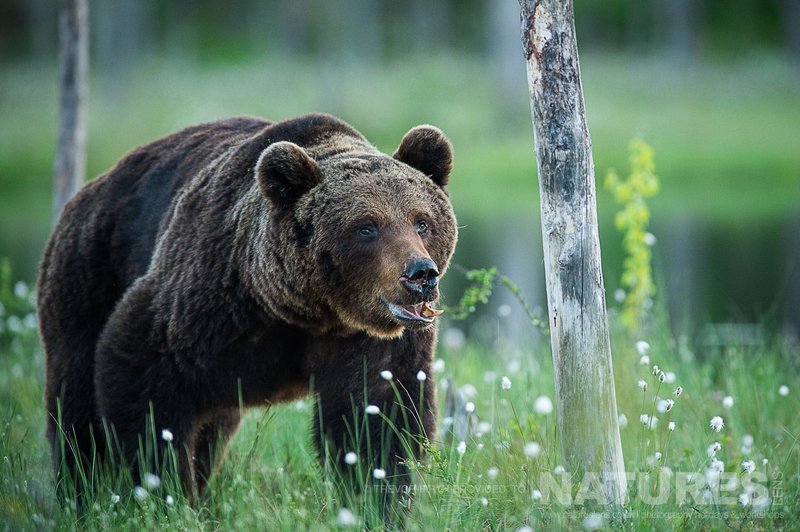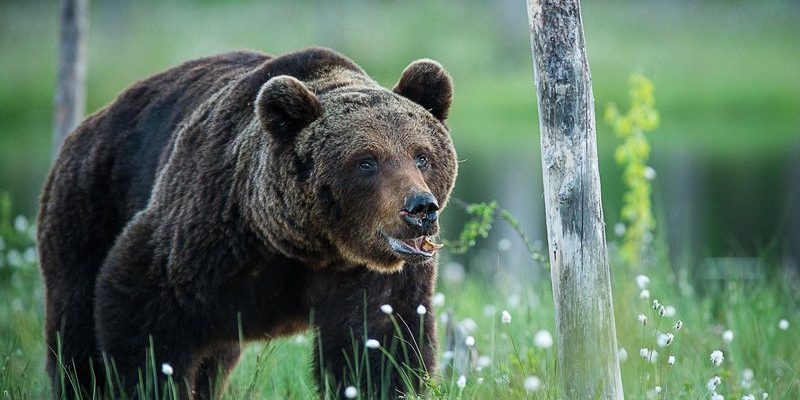
Have you ever seen a bear lumbering through a forest or fishing in a stream? The Brown Bear is one of the most impressive and beloved animals on the planet. Known for its majestic size and powerful presence, the brown bear represents both strength and vulnerability in the wild. These creatures are not just massive; they are incredibly intelligent, adaptable, and play a crucial role in their ecosystems.
From the rugged mountains of Alaska to the dense forests of Europe, brown bears command respect and intrigue. They are a symbol of the wilderness, often portrayed in stories and folklore as wise, powerful beings. But what makes them unique? And how do they adapt to survive in a world that’s ever-changing? Let’s dive into the fascinating life of the brown bear and uncover what makes this species so remarkable.
Physical Characteristics
Brown bears are known for their impressive physique. On average, they can weigh between 300 to 1,500 pounds, depending on their age, sex, and food availability. Adult males are generally larger than females. You might picture them with their shaggy brown fur, which can vary from light tan to almost black, depending on the subspecies and the environment they inhabit. Their long claws and strong limbs enable them to dig for food or climb trees when necessary—though their hefty weight often keeps them grounded.
Their front paws are particularly strong, featuring claws that can grow up to four inches long. These claws are perfect for tearing apart logs to find insects or for catching fish in streams. Additionally, brown bears have an acute sense of smell, said to be about seven times better than a bloodhound’s. This keen sense helps them locate food—even miles away! You might be surprised to learn they also have excellent hearing and can see quite well, although they rely primarily on their sense of smell to navigate their world.
| Size | 3.3 to 10 feet in length |
| Weight | 300 to 1,500 pounds |
| Habitat | Forests, mountains, tundras, and coastal regions |
| Diet | Omnivorous; includes fish, berries, roots, and small mammals |
| Life Span | 20 to 30 years in the wild |
| Speed | Up to 30 miles per hour |
Habitat and Distribution
Brown bears are found across a wide variety of habitats, which showcases their adaptability. They thrive in forests, mountains, tundras, and even coastal regions. You might imagine them in places like Alaska’s vast wilderness or the rugged terrains of the Russian Far East. Their distribution spans across North America and parts of Europe and Asia, but not all brown bears live in the same conditions. For example, the grizzly bear, a subspecies of the brown bear, primarily inhabits the western United States and Canada.
These bears tend to prefer areas with abundant food sources, such as salmon-rich rivers or berry-laden meadows. During summer, they often roam in search of food before preparing for hibernation in colder months. Hibernation is a fascinating aspect of their life—while they sleep for several months, their bodies enter a state of dramatically reduced metabolism, allowing them to survive on their fat reserves. You might wonder how they navigate these varying environments. The answer lies in their keen instincts and observations of seasonal changes.
Diet and Feeding Habits
As omnivores, brown bears have a diverse diet, which significantly influences their behavior and habitat choices. Their meals can include fish, berries, roots, small mammals, and even carrion. In many regions, salmon is a dietary staple, and you’ll often see bears fishing in rivers during the salmon spawning season. They are also known for their impressive ability to forage, using their claws to dig in the ground for roots or insects. Imagine a bear turning over rocks or logs in search of a tasty snack; it’s a remarkable sight!
Feeding is not just about survival; it’s a social activity as well. Bears often gather in groups during peak feeding times, showcasing a level of social interaction that might surprise you. Despite their size, they can also be surprisingly agile when chasing prey or climbing trees. In the animal kingdom, their ability to consume a variety of foods makes them essential for ecosystem health, as their feeding habits help disperse seeds and maintain plant diversity.
Behavior and Social Structure
Brown bears are primarily solitary animals, with the exception of mothers with cubs or during mating season. They can be quite territorial, especially males. Despite their solitary nature, you’ll find that they exhibit fascinating social behaviors, particularly among females and their young. Mothers are incredibly nurturing, staying with their cubs for about two to three years, teaching them critical survival skills. You might picture a mother bear protecting her cubs as they learn to fish or forage—it’s a tender and powerful dynamic.
When food is plentiful, you can witness a fascinating hierarchy among bears. Larger, dominant bears tend to eat first, while smaller or younger bears may wait their turn. There’s an element of respect in these interactions, as each bear understands its place in the social order. You might be surprised to hear that while they may appear aggressive, much of their behavior is rooted in communication rather than confrontation. Bears will often use vocalizations, body language, and even scent marking to communicate with one another.
Reproduction and Lifespan
Brown bears typically reach sexual maturity between three to five years of age. During the mating season, which usually occurs in late spring, males will compete for the attention of females by displaying strength and stamina. After a successful mating, the female bear undergoes a fascinating process called delayed implantation. This means the fertilized egg doesn’t implant immediately but waits until the mother has gained enough weight to support pregnancy, typically around November. This ensures that cubs are born during the spring when food is abundant.
The gestation period lasts about eight months, after which a mother bear usually gives birth to one to four cubs in a den. These cubs are born blind, hairless, and incredibly vulnerable, weighing just about one pound at birth. They rely entirely on their mother for warmth and nourishment. You can imagine the bond between them as the mother protects and nurtures her tiny offspring during the harsh winter months. In the wild, brown bears can live up to 20 to 30 years, though many face dangers from poaching or habitat loss.
Conservation Status
The conservation status of brown bears varies depending on their specific subspecies and geographical region. While some populations are thriving, others as in certain areas of Europe, are facing serious threats. Habitat loss due to human encroachment, climate change, and poaching have all contributed to declining numbers in certain populations. Conservation efforts are essential to ensure the survival of these magnificent creatures. Organizations are working tirelessly to create protected habitats, implement anti-poaching measures, and raise awareness of the importance of biodiversity.
It’s inspiring to see how communities come together to protect these animals. Eco-tourism has gained traction in many regions, enabling locals to benefit from the presence of brown bears while also conserving their habitats. When you think about it, protecting brown bears is about more than just saving one species; it’s about preserving the interconnected web of life on our planet.
FAQ
What are the different subspecies of brown bears?
There are several subspecies of brown bears, including the Grizzly Bear, Kodiak Bear, and Eurasian Brown Bear, among others. Each subspecies has adapted to its specific habitat, leading to variations in size, fur color, and behavior. For example, the Kodiak Bear, found on Kodiak Island in Alaska, is one of the largest bears in the world, while the Eurasian Brown Bear is found across Europe and Asia and tends to be slightly smaller.
How do brown bears hibernate?
Brown bears hibernate by entering a state of torpor during winter months. They find a cozy den, often excavating a spot in the snow or finding a sheltered location. Their heart rates drop significantly, and they rely on stored fat for energy during this period. Interestingly, females give birth while hibernating, and their cubs stay with them in the den until spring. This hibernation process is crucial for their survival, allowing them to conserve energy during harsh conditions.
What do brown bears eat?
Brown bears are omnivorous, meaning they eat both plants and animals. Their diet typically includes berries, roots, fish, small mammals, and carrion. They are especially known for their fishing skills during salmon spawning season. The availability of food sources influences their behavior and habitat choices, and they adapt their diet based on what is accessible in their environment.
Are brown bears dangerous to humans?
While brown bears can be dangerous if approached, most incidents occur when bears feel threatened or surprised. They typically avoid human contact. Understanding bear behavior and respecting their space is essential when encountering them in the wild. It’s important to follow safety guidelines when hiking in bear country to minimize risks.
How fast can brown bears run?
Brown bears can run surprisingly fast for their size—up to 30 miles per hour! This speed is useful for both catching prey and escaping threats. Despite their bulk, they can move swiftly, so it’s essential to give them plenty of space in the wild.
What is the lifespan of a brown bear?
In the wild, brown bears typically live around 20 to 30 years, although their lifespan can be longer in protected environments. Factors such as food availability, habitat conditions, and human interactions significantly impact their lifespans. Bears in captivity can live even longer, often reaching into their 30s or 40s.
What role do brown bears play in their ecosystem?
Brown bears play a vital role in their ecosystems as top predators and scavengers. By preying on various animals, they help maintain balance in the food chain. Their foraging habits also contribute to seed dispersal, promoting plant diversity. Essentially, healthy bear populations support the overall health of their habitats, making their conservation critical.
Can brown bears swim?
Yes, brown bears are excellent swimmers! They often swim across rivers and lakes in search of food or while migrating. Their strong limbs and buoyant bodies make swimming a natural and effective way for them to navigate their environments, especially in coastal regions.
Are brown bears social animals?
Brown bears are generally solitary creatures. However, they can exhibit social behaviors, particularly during feeding or mating seasons. Mothers with cubs display strong social bonds with their young, and you’ll find that they occasionally communicate through vocalizations or body language with other bears. Social interactions are especially noticeable when food is abundant, as different bears can establish a hierarchy based on size and strength.
How can we help protect brown bears?
Protecting brown bears involves supporting conservation efforts, promoting awareness about their habitat needs, and respecting wildlife regulations in bear countries. By choosing eco-friendly practices, reducing waste, and advocating for policies that protect their habitats, you can help ensure the survival of these magnificent creatures for future generations.

